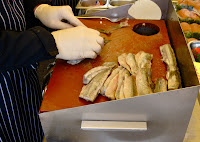Do carrots, broccoli, asparagus, fennel, peas, string beans, tomatoes, squash, and potatoes really need elaborate sauces to bring out their flavors?
The Italians get it right, in my opinion. Buy the best ingredients and get out of the way.
And yet, there are times when a little more spice or a variety of flavors is needed to reinvigorate the palate. A few drops of fresh citrus juice, a dusting of cayenne, a sprig of fresh rosemary, or a drizzle of nam pla can transform the familiar into the exciting.
And yet, there are times when a little more spice or a variety of flavors is needed to reinvigorate the palate. A few drops of fresh citrus juice, a dusting of cayenne, a sprig of fresh rosemary, or a drizzle of nam pla can transform the familiar into the exciting.
Authentic Indian curries are complex combinations of a dozen spices and herbs. An easy-to-make version for every day use can be made with a packaged curry powder or pulled together with five basic elements: fresh garlic, turmeric, cumin, coriander, and coconut milk.
Keep the curry vegetarian if you want or add poultry, seafood, or meat. The choice is yours. Since my wife doesn't eat poultry or meat, but I do, I start with vegetables and spices to build the flavors, make her portion, then add meat for mine. That way we're both happy.
The best part is that an affordable and delicious meal can be prepared in 30 minutes or less.
Basic Curry
Use whatever fresh vegetables you enjoy. For stock, homemade is best, as much for flavor as for avoiding excess salt. It's easy enough to make chicken or vegetable stock and freeze it.
A side note: with the vegetable peelings, make a stock by putting them into a pot with 4 cups water, simmer 30 minutes, run through a food mill, and collect the liquid and solids to use for the curry or freeze to use when needed.
A side note: with the vegetable peelings, make a stock by putting them into a pot with 4 cups water, simmer 30 minutes, run through a food mill, and collect the liquid and solids to use for the curry or freeze to use when needed.
Find an organic coconut milk that doesn't use chemical preservatives. Freeze what you don't use for later use.
Yield: 4 servings
Time: 30 minutes
Ingredients
1 onion, peeled, roughly chopped
2 garlic cloves, peeled, finely chopped
4 carrots, washed, peeled, cut into thick rounds
1 large Yukon gold potato, washed, peeled, roughly chopped
1 head of broccoli, washed, florets cut into bite sized pieces, stems peeled and chopped
2 cups mushrooms, brown or shiitake, washed, thin sliced
1 corn on the cob, husk and silk removed, washed, kernels removed
1 corn on the cob, husk and silk removed, washed, kernels removed
1 teaspoon turmeric
1 teaspoon ground coriander
1 teaspoon cumin
1 cup coconut milk
2 cups liquid, water or stock
2 tablespoons olive oil
Sea salt and pepper
Method
In a large saucepan, heat 1 tablespoon of olive oil and saute the vegetables until lightly browned. Remove. Add the other tablespoon of olive oil and saute the garlic and spices until lightly browned. Return the vegetables to the pan and toss well.
Pour in the liquid (water or stock) and coconut milk. Stir well to deglaze the pan and combine the flavors. Simmer on a medium-high heat for 15 minutes. Taste and adjust seasoning with sea salt and pepper.
Serve with rice, pasta, or steamed spinach.
Curry with Sausage and Chicken
Including meat in the dish adds only 5 minutes to the preparation time. Leftover meat can also be put to good use here.
Yield: 4 servings
Time: 35 minutes
Ingredients
2 Italian sausages, cut into rounds or bite sized pieces
1 chicken breast, cooked, cut into bite sized pieces
1 onion, peeled, roughly chopped
2 garlic cloves, peeled, finely chopped
1 cup Italian parsley, washed, finely chopped, leaves only
4 carrots, washed, peeled, cut into thick rounds
1 large Yukon gold potato, washed, peeled, roughly chopped
1 head of broccoli, washed, florets cut into bite sized pieces, stems peeled and chopped
2 cups mushrooms, brown or shiitake, washed, thin sliced
1 teaspoon turmeric
1 teaspoon ground coriander
1 teaspoon cumin
1 cup coconut milk
2 cups liquid, water or stock
2 tablespoons olive oil
Sea salt and pepper
Method
In a large saucepan, heat 1 tablespoon of olive oil and saute the sausage and chicken until lightly browned. Remove.
In the same pan saute the vegetables until lightly browned. Remove. Add the other tablespoon of olive oil and saute the garlic and spices until lightly browned. Return the meat and vegetables to the pan and toss well.
Pour in the liquid (water or stock) and coconut milk. Stir well to deglaze the pan and combine the flavors. Simmer on a medium-high heat for 15 minutes. Taste and adjust seasoning with sea salt and pepper.
Serve with rice, pasta, or steamed spinach.
Variations
Add one large ripe tomato, washed, roughly chopped
Add 1/4 teaspoon cayenne for heat
Add 1/4 teaspoon cayenne for heat
Add tofu cut into bite sized pieces
Add 1 package of spinach, washed, keep leaves whole but finely chop the stems after you add the liquid
Add 1 pound raw shrimp, washed, shelled, deveined in the last 5 minutes of cooking
Add 3 cups fresh clams or mussels, washed, with the stock and coconut milk
Add to the vegetable saute 2 cups roughly chopped green or red cabbage
Add to the vegetable saute 2 Japanese eggplants, washed, stems removed, roughly chopped
Add to the vegetable saute 1 cup raw cashews
Add to the vegetable saute 2 cups roughly chopped green or red cabbage
Add to the vegetable saute 2 Japanese eggplants, washed, stems removed, roughly chopped
Add to the vegetable saute 1 cup raw cashews
Add to the vegetable saute 1 tablespoon ginger, peeled, finely minced

























